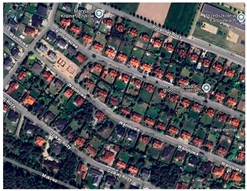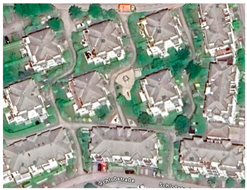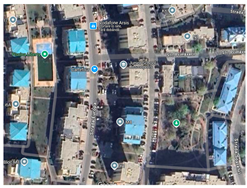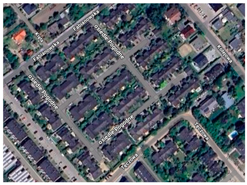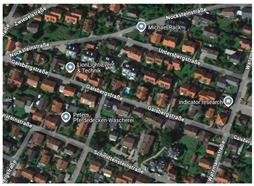Abstract
Living close to green infrastructure (GI) components might be the dream of many people who are often exposed to cities’ pollution, congestion, or lack of green amenities. Due to its multiple benefits, green infrastructure plays a significant role in driving people’s decisions to leave inner-city areas and move to suburban locations. However, how GI components are used once people move into the suburbs must be better understood. Thus, this study explores residents’ rationales for leaving the inner city and moving to the suburbs and how they use suburban GI components. A survey was undertaken in six suburbs from three European cities: Poznań (Poland), Salzburg (Austria), and Bucharest (Romania). We found that people self-reported that green amenities were the main reason for choosing a suburban residence. Furthermore, those residents who moved to the suburbs were more interested in using their private gardens than larger parks and prefer natural green areas with high potential for recreation to agricultural landscapes for leisure. This study advocates for investment in private green spaces in suburban developments due to their deep interweaving with residents’ leisure preferences.
1. Introduction
The expansion of residential housing from urban to suburban areas is driven by a combination of socio-economic (i.e., real estate process, tenancy), environmental (i.e., better air quality, access to recreational/green areas), as well as technological factors (i.e., telecommuting) [1,2,3]. More emphasis is placed on green infrastructure (GI) due to its vital role in making suburbs attractive [4,5]. Most definitions of GI [6,7,8,9,10] conceptualize it as an interconnected, strategically planned network of natural and semi-natural areas, including components of natural ecosystems (i.e., forests, rivers, lakes) and man-made features (i.e., private gardens, constructed parks).
Previous studies have recognized the importance of being close to GI components for social benefits, such as improving human wellbeing [11,12], and physical [13] and mental health [14,15]. Furthermore, green spaces can enhance longevity [16], environmental awareness [17], neighborhood satisfaction [18], and social cohesion [19].
People change their inner-city residences and settle in the suburbs for multiple reasons. Ref. [20] indicate that people have high expectations regarding the new residence when they move from the inner city to the suburbs as suburban housing has become more appreciated due to affordability in terms of land costs, size of home, newness of housing, and more access to green spaces [21,22]. Ref. [23] found that the environmental quality of the new area and the price or accessibility of the new residence are among the most important reasons for choosing a new home. However, relocating to suburban areas brings numerous challenges regarding social integration and access to infrastructure, particularly public transportation [24,25]. Limited access to job opportunities represents a significant issue, forcing many residents to endure long commutes to urban centers for employment [26,27]. Another major disadvantage is social isolation, often caused by the lack of adequate community infrastructure, which particularly impacts vulnerable groups, such as the elderly [28].
Additionally, suburban areas frequently offer limited access to other essential services, such as healthcare and educational facilities, forcing residents to travel longer distances for these needs. This can deepen economic inequalities, especially for low-income families [29]. These limitations in transportation and services reduce social mobility and contribute to unequal access to employment and resources [30]. Furthermore, residential segregation intensifies such inequalities, fostering social exclusion and making suburban relocation a problematic option for certain population groups.
Being close to green amenities has been found by several studies to be the primary motivation for the desire to live in suburban areas in Europe [23,31,32], Asia [33], and the United States [34]. In cases where it is not the primary motivation, it becomes a ‘post hoc rationalization’ [35], and whatever the real motivations are for people to move out from the inner city to the suburbs, they justify their decisions by pointing to the green amenities which they should value because they were willing to pay extra to live close to them. When people do not move for the green amenities in the suburbs, they often invoke privacy [36] or founding a family [37,38] as the primary motivations.
Residents make trade-offs between suburban and inner-city housing choices when proximity to GI components is of interest. They usually trade off accessibility to services and jobs if a green residential environment is provided. This often happens when they can afford to travel [39]. The types of GI components residents prefer are small, man-made features, such as gardens [40], mainly used for private recreational activities. In cases where large open areas and meadows dominate suburban landscapes, people report decreased satisfaction with the overall quality of the green space [41].
Many suburban residential areas are often advertised to offer closeness to GI components without being clear about how much the residents use them. Information on how GI components are used by residents moving to the suburbs has been overlooked in past research and planning strategies [42]. Therefore, this study investigates how people use GI components in six suburban residential projects with different GI components in their proximity. This study accounts for spatial and cultural differences to inform the design approaches for suburban housing developments to make them more intertwined with residents’ leisure preferences.
2. Materials and Methods
2.1. Study Area
This study was conducted in six suburban residential projects from three cities (Poznań in Poland, Salzburg in Austria, and Bucharest in Romania). Two suburban residential projects per city were selected: (i) one having proximity to high-quality GI components (mostly natural green areas with high potential for recreation (i.e., parks, forests) and blue (i.e., small rivers or lakes) spaces), (ii) the other one having proximity to low-quality GI components (mostly large open spaces, agricultural landscapes). We considered ‘proximity’ a buffer zone of 1000 m straight-line distance from the suburban project, associated with approximately 15 min walking distance [43].
Poznań is located in the lowland along the Warta River and covers an area of 26,200 ha, of which green and blue areas represent 53%. Poznań’s densely populated inner city is characterized by tenement housing and numerous public buildings. Multi-family residential units mainly represent the next intermediate zone, while the outskirts are dominated by agricultural landscapes, single-family houses, and recreational areas [44]. Poznań is the fifth-largest city in Poland, with 538,400 inhabitants [45], with a population density of 2060 persons per km2. According to [46] and [47], since the early 1990s, the population in Poznań has been decreasing, while in all communes of the area of Poznań, particularly in the communes directly bordering the city, the number of inhabitants has been increasing. Looking for a higher quality of life, people moved from the city to the rural, suburban zone. Two suburban residential projects were selected as case studies: (i) a residential project in the southern part of Kamionki village, which is located south of Poznań and (ii) Pogodne and Wiśniowa residential projects located in the southern part of Plewiska village, which is located south-west of Poznań (Figure 1). The first case in Kamionki village represents single-family houses with a few terraced houses, each owning a small garden. The residential project is surrounded by forests from the south and agricultural landscapes to the north. The second case study includes terraced houses in a gated area, the predominant type of building, with few single-family houses in gated areas. The case study area is surrounded mainly by arable lands; in the northwest, it borders other built-up areas.
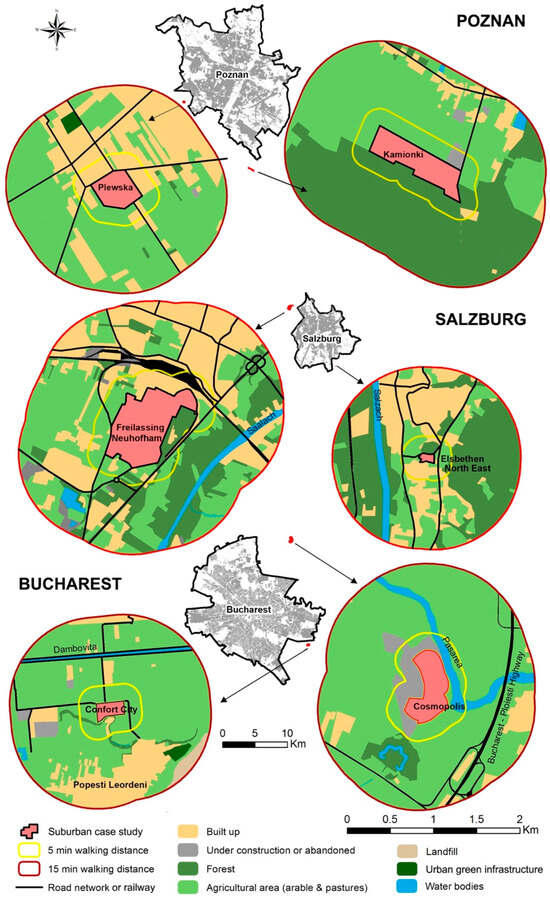
Figure 1.
The suburban case studies.
Salzburg is Austria’s fourth-largest city, with 158,000 inhabitants [48], located at the Alps’ northern fringe. It covers an area of 6567 ha, of which 58% is green and blue infrastructure, and 34% is built-up land [49], with fewer green areas in the north of the city. Salzburg’s inner city is densely built, while the city outskirts are sparsely built with single-family houses and multi-story buildings [50]. Two suburban residential projects were selected as case studies: (i) Elsbethen, located south of Salzburg, and (ii) Freilassing-Neuhofham, located north of Salzburg. The first case study includes a residential project with three-story buildings which are individually owned. It accommodates middle- and upper-class people, dominated by older people and families with children. It has a small park, children’s playground, and semi-public managed green areas around the buildings. The surroundings are highly attractive and diverse regarding leisure and recreation in nature, with forest areas, walking trails, and open agricultural land. The second case study includes single and detached houses where middle- and upper-class people live. Average good families with children and older people prefer it. The surroundings are dominated by agricultural landscapes with less diverse green spaces.
Bucharest is the capital of Romania and has the largest population concentration in southeast Europe, with 1.7 million residents and a population density of over 7100 inhabitants per km2 [51]. It covers a total area of 23,800 ha, of which green areas represent 19% and blue areas represent 6% [52]. Since 1989, after the communist breakdown, the residential areas have expanded, with the highest rate between 2005 and 2008 (500 ha, half of which were newly built residential areas outside the city’s built-up limit). The northern parts of the city have been preferred for residence by upper-class residents due to well-developed GI compared to the southern region, which is more fragmented [53]. Two suburban residential projects were selected as case studies: (i) Cosmopolis, located north of Bucharest, and (ii) Confort, located southeast of Bucharest (Figure 1). Cosmopolis is a gated community with buildings consisting of three to seven-story villas, including commercial and educational facilities, which are still developing. It contains small private green spaces destined for the use of residents and over ten swimming pools. It is surrounded by green areas represented mainly by forests and agricultural land, with a high environmental quality due to its location in an area with extensive natural landscapes. It is also located on a small river, having access to a private beach (Table 1, Table 2 and Table 3, Figure 1). Confort comprises 11-story buildings with various infrastructure (shopping facilities, kindergarten, playgrounds, etc.), extensive parking, and small green spaces (only lawns). The surrounding area of Confort is dominated by agricultural landscapes or other built-up areas, such as a rendering plant, a wastewater treatment plant, and a landfill (Figure 1), which generate negative impacts and diminish the environmental quality in the area. Forests and agricultural areas in Romania are not usually enclosed or guarded; therefore, people can walk using the existing paths if they desire.

Table 1.
The characteristics of the case studies.

Table 2.
Different land uses (%) within 5 and 15 min distances in the case studies.

Table 3.
The selected suburban case studies. Satellite images by Google Maps.
Buffer polygons were created around each case study area (Figure 1) to determine the ‘proximity’. Furthermore, we considered GI components: natural green areas with high potential for recreation (e.g., forests), blue areas (e.g., small lakes and rivers), and agricultural landscapes (e.g., arable land and pastures) (Figure 1).
2.2. Methods
Data were collected using a standardized survey to evaluate residents’ motivations for leaving their former residence and choosing a suburban residence, and how they use the GI components after moving to the suburbs. The survey was conducted in person and online according to the characteristics of the case studies (retired persons predominate in the selected suburban residential areas from Salzburg, while many young people live in those from Bucharest) and accessibility.
The targeted group consisted of residents of the suburban case studies. Random and snowball samplings were used to distribute the surveys. In the latter case, researchers identified an initial group of respondents from their professional and personal contacts network. The sample expanded based on referrals made among the initial group of respondents. 82% of the sample was selected using random procedures in the case studies from Poznań and Salzburg, while 18% used the snowballing technique in the case studies from Bucharest. The case studies from Bucharest are gated housing estates, and a snowball sampling approach was more appropriate for reaching their residents.
The surveys were administered from June–August 2016. A total of 242 valid surveys were retrained for data analysis. The survey included the following construct: (i) the motivations of people for leaving the previous residence and moving to the suburbs, (ii) the leisure time and how they use the GI components in the proximity zone, and (iii) residents’ social characteristics (i.e., gender, age, education) (Supplementary Materials, Table S1). Some of the survey items were measured on a five-point Likert scale ranging from: (1) strongly irrelevant reason to (5) strongly relevant reason (i.e., questions 2 and 4, Supplementary Materials, Table S1). Likert statements were adopted due to their effectiveness in understanding residents’ perceptions about green spaces [54,55,56].
The survey (Supplementary Materials, Table S1) was initially written in German, then translated into Polish and Romanian, and edited by native speakers to ensure accuracy and readability. Our original survey investigates the preferences of people who move to suburban areas and their leisure patterns in three regions with different development patterns and cultural influences. While other studies developed surveys that focus on the push or pull reasons for mobility, including closeness to nature (i.e., [20,57]), our study deepens the knowledge about the role that GI plays in choosing a suburban residence by collecting preferences for leisure time and GI components within and outside people’s suburban neighborhood. A further strength of our survey is that some questions use data extracted from the spatial analysis to understand better the types of GI components people use for leisure.
Descriptive and inferential statistics were used to analyze survey data. The analyses were performed in R [58]. We used non-parametric statistical tests (Kruskal–Wallis) to test for differences between the suburban residential projects and the cities. Frequency tables were used to describe residents’ social characteristics and leisure time while diverging stacked bar graphs were used to illustrate Likert scale data [59] (Figure 2).

Figure 2.
Flowchart of this study; GI—Green Infrastructure; Green—suburban residential areas having high-quality GI components in proximity; Orange—suburban residential areas having low-quality GI components in proximity.
3. Results
3.1. Sample Profile and Demographic Characteristics
Data show that more females responded to the survey in Kamionki and Plewiska (Poznań), Elsbethen (Salzburg), and Cosmopolis (Bucharest). At the same time, in Freilassing-Neuhofham (Salzburg) and Confort (Bucharest), over half of the respondents were males (Table 4). In all three cities, the gender composition includes more females than males [45,48,60]. Respondents in Salzburg’s two suburban case studies were older than those from Poznań and Bucharest. The younger respondents were dominant for the two case studies from Bucharest (86% and 91%, respectively, younger than 40). For the educational level, most of the respondents were highly educated (more than 74%). In the two case studies from Salzburg, professional education was also dominant. Higher levels of university education represent the study regions, as all three cities are among each country’s most important university centers [44,61]. Regarding employment, more than 60% of the respondents had a full-time position except for Elsbethen (Salzburg), where a good share of respondents were retirees (44%), and Plewiska (Poznań), where several respondents were on maternity/child care leave (24%).

Table 4.
The characteristics of the targeted group.
Regarding the respondents’ former place of residence, they generally moved from the inner city to the suburbs, except for Plewiska (Poznań), where the former residence place was also in the suburbs. Most respondents previously lived in a collective residential unit (Table 4). Most of them had children, except for the Cosmopolis and Confort case studies (Bucharest), where there was a roughly equal number of respondents who had children (48%, 57%) and respondents who did not have children (52%, 43%). Most respondents in the Elsbethen residential project (Salzburg) did not have children (78%).
3.2. Motivations to Leave the City
According to the ratings of the eleven statements explaining why the respondents left their former place of residence, the motivation most frequently reported refers to the size of the former place in all case studies, except for Cosmopolis (Bucharest), where respondents pointed out the ‘lack of recreation areas’ as the main motivation for leaving their former place of residence, in addition to its ‘size’ (Figure 3). Furthermore, reasons such as ‘family issues’ or ‘better financial situation’ were frequently reported. The least frequent motivation refers to ‘conflicts with the neighborhood’, except for residents living in Freilassing-Neuhofham, where the least reported reasons refer to ‘air pollution’ and ‘lack of security’ (Figure 3).
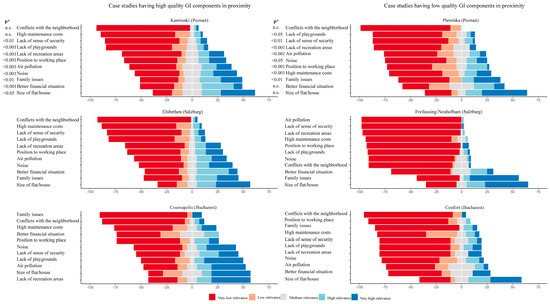
Figure 3.
Respondents’ motivation for leaving their former place of residence. * Significant difference level between (i) Kamionki, Elsbethen, and Cosmopolis and (ii) Plewiska, Freilassing-Neuhofham, and Confort survey means using Kruskal–Wallis tests.
3.3. Motivations to Move to the Suburbs
The most common motivations for choosing a suburban residence in all three cases having in proximity mostly natural green and blue areas with high potential for recreation refer to the ‘natural amenities around the residential areas’, being the only reason with no significant differences, closely followed by ‘the overall environmental conditions’ and ‘facilities/quality of apartment or house (outdoor)’ (Figure 4). People moved here to enjoy the multiple benefits of green and blue spaces. Along with better environmental conditions, respondents also reported the indoor quality as a motivation for choosing the suburban residence, in the case of Cosmopolis (Bucharest) ( = 4.38).

Figure 4.
Respondents’ motivations to move to the suburbs. * Significant difference level between (i) Kamionki, Elsbethen, and Cosmopolis and (ii) Plewiska, Freilassing-Neuhofham, and Confort survey means using Kruskal–Wallis tests.
In all three case studies with low-quality GI components, most respondents chose their suburban residence for the ‘facilities/quality of apartment or house (outdoor)/(indoor)’ and ‘size of flat/house’. For these respondents, the place’s physical characteristics were more important than the green ones. Indoor quality, proximity to the workplace and education, and environmental conditions are motivations with significant differences between the three residential projects (Figure 4).
3.4. The Use of GI Components in the Suburbs
After moving to the suburbs, most of the respondents from all six case studies spend their leisure time (one to five hours during the week and more than five hours during the weekend) in their private houses and gardens (Table 5). In Elsbethen (Salzburg), almost half of the respondents have more than five hours of leisure time during the week (48%), mainly because half of them are retirees (44%) and spend their leisure time mostly in their private houses, both during the week and at weekends. In the two cases from Bucharest, a good share of respondents spend their leisure time in private and public gardens (Table 5).

Table 5.
Respondents’ leisure time during the week and at weekends.
Over half of the respondents in Cosmopolis and Confort residential projects (Bucharest) use urban parks for leisure both during the week and weekends. In Plewiska (Poznań) they use urban parks mainly at weekends. The second home is a place for leisure time, primarily for respondents in the two cases from Bucharest (more than 33%). In the case studies from Salzburg, the natural surroundings are more frequently used for leisure than the urban parks (Table 5).
Most respondents from all case studies spend their leisure time several times or once per week in private residential green facilities and in the GI components in proximity. Here, they choose activities such as walking with children in Plewiska (Poznań) and Freilassing-Neuhofham (Salzburg), riding a bike/skating in Kamionki (Poznań), swimming in Cosmopolis (Bucharest), and nature observation in Elsbethen (Salzburg) and Confort (Bucharest) (Supplementary Materials, Table S2).
More than half of respondents walk several times per week in the proximity buffer zone, except for Freilassing-Neuhofham (Salzburg), where respondents go for walks less often (Table 6). Respondents report that they regularly visit in the proximity zone (i) water bodies in Elsbethen (Salzburg) ( = 4.08) and Cosmopolis (Bucharest) ( = 3.48); (ii) meadows and pastures in Freilassing-Neuhofham (Salzburg) ( = 3.68) and Confort (Bucharest) ( = 2.65); as well as (iii) forests (= 3.94) and (iv) gardens ( = 2.90) in Kamionki and Plewiska (Poznań), respectively (Figure 5).

Table 6.
Residents’ leisure time in the case studies having high-quality GI components in proximity.
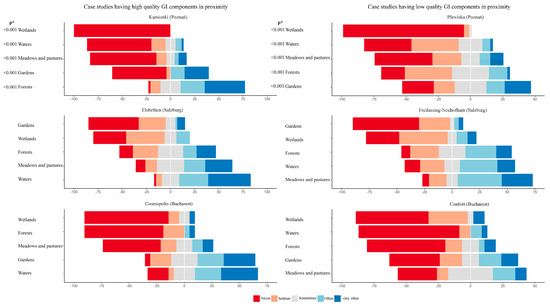
Figure 5.
GI components respondents visit in their proximity. * Significant difference level between (i) Kamionki, Elsbethen, and Cosmopolis and (ii) Plewiska, Freilassing-Neuhofham, and Confort survey means using Kruskal–Wallis tests.
Most respondents use GI components less frequently outside the proximity buffer zone than in close proximity. When they use GI components (outside of the proximity zone), they do it one to two times per month or several times per month, except for Confort (Bucharest), where a little over half of respondents (55%) spend leisure time several times per week in GI components outside of the proximity zone (Table 7). Most respondents from the two case studies from Salzburg spend less of their leisure time in GI components outside of the proximity zone than respondents from Poznań and Bucharest (Table 7). Respondents generally choose to visit GI components outside of the proximity for riding a bike/skating in Kamionki (Poznań), nature observation in Elsbethen (Salzburg), Cosmopolis and Confort (Bucharest), meeting with other people in Plewiska (Poznań), and swimming in Freilassing-Neuhofham (Salzburg) (Supplementary Materials, Table S2).

Table 7.
Leisure time of residents in the case studies having low-quality GI components in proximity.
The respondents from Salzburg go for a walk less often in GI components outside the proximity zone (more than 60%). In contrast, the respondents from Poznań and Bucharest spend more time in GI components outside the proximity zone (Table 7). Outside the proximity zone, respondents report that they regularly visit forests in Kamionki (Poznań) ( = 2.71) and Confort (Bucharest) ( = 3.04), water bodies in Elsbethen ( = 3.86) and Freilassing-Neuhofham (Salzburg) ( = 4.16), and gardens in Cosmopolis and Confort (Bucharest) ( = 3.00 and = 3.04 respectively) and Plewiska (Poznań) ( = 2.56) (Figure 6).
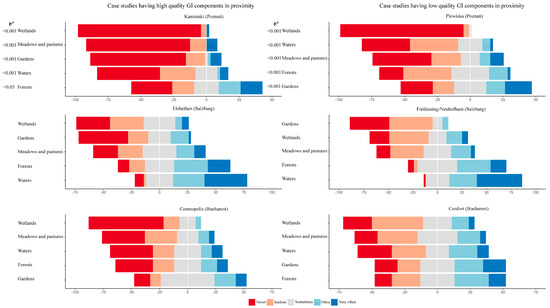
Figure 6.
GI components respondents visit outside their proximity. * Significant difference level between (i) Kamionki, Elsbethen, and Cosmopolis and (ii) Plewiska, Freilassing-Neuhofham, and Confort survey means using Kruskal–Wallis tests.
According to the mean ratings of the seven reasons that limit respondents from using GI components in close proximity, respondents generally do not have enough time to use them or report the absence of green spaces, as in the Confort case study (Bucharest) and Plewiska case study (Poznań) (Table 8). Significant differences have been found between the residential projects with GI in close proximity, except for the reasons reporting ‘lack of security’ and ‘lack of recreation’.

Table 8.
Means of respondents’ motivations that limit them from using GI components in proximity.
4. Discussion
4.1. Why Leave the City
In all six case studies, most people left their former residence mainly because of its size. Other studies highlight the importance of larger homes in determining the decision of people to leave their former residences [23]. Small flats represent an essential reason people move to the suburbs in old industrial inner-urban areas [20]. Furthermore, the only way to get a larger home in old European cities is to move to the suburbs. In Bucharest case studies, in addition to the size, people left their former residence also because of the poor environmental conditions (i.e., ‘lack of recreational areas’, ‘air pollution’). This can be explained by the fact that among all the analyzed cities, Bucharest has the smallest percentage of green spaces and the highest proportion of built-up areas and subsequent air quality problems [62]. The lack of green spaces was found in other studies to be the second most important motivation for moving from the inner city to the outskirts of former industrial cities [20]. Changes in people’s private lives (i.e., ‘better financial situation’, ‘family issues’) are also important motivations for leaving the inner city for a residence in the suburbs. This applies also to the city of Łódź (Poland) and Brno (Czech Republic) [37].
4.2. Why Move to the Suburbs
The three case studies with high-quality GI components in proximity were chosen for their green amenities. This finding is in accordance with other studies that suggest that proximity to green spaces is the most important reason for choosing a residence on the city’s outskirts for the cities of Leipzig [20], Barcelona [23], as well as Lisbon [63]. Perhaps this is due to income differences, as higher-income people can choose homes based on their amenities. Conversely, the three case studies with low-quality GI components in proximity are generally chosen for their size and indoor quality. This suggests that people with middle incomes try to maximize the value of their money. Significant differences exist between the motivations for choosing a suburban residence (i.e., those motivations referring to a good location and different necessary amenities: working and education) in the case studies having low-quality GI components in proximity. This can be explained by the different cultural contexts of the three cities in three countries. In Poland, suburban residents maintain strong connections to the city, continuing to use such services because they remain attached to them, and those available in the suburban area are considered scarce or of low quality [64]. In Romania, people prefer a residence close to such services for comfort-oriented reasons. Also, in Austria, the new suburban dwellers stay close to the central cities from where most of them came. They have left the city because of discrepancies between their demands on living conditions, including contact with nature, its availability and the high price for this in the city [65].
4.3. Suburban GI Components
When residents have free time, they use different GI components for leisure. Our results show significant differences in the use of private gardens, community gardens, and urban parks between all selected case studies. Community gardens are generally not used by residents who have a private garden at their house. Urban parks are used more for leisure time in Bucharest than in Poznań and Salzburg, even if they are not in the immediate proximity of the suburban residential area. This may be an effect of the age group (younger people) being significantly different in Bucharest and the lack of community gardens. Other studies assessing people’s use of suburban green spaces found a stronger preference for urban green spaces among younger people while the elderly prefer less ‘urban’ green spaces [66]. Furthermore, younger people usually pursue fewer nature-related activities than older people [67], which might explain the preference for urban parks compared to community gardens among younger people.
Secondary homes are used for leisure time only by residents from the case studies in Bucharest. This can be connected to the types of buildings. While the case studies in Poznań and Salzburg have private gardens, in the case studies in Bucharest, the multi-story buildings are predominant. This may determine whether people should spend their leisure time in secondary homes. Furthermore, Romania experienced unique changes in the housing field compared to Austria and Poland, where the post-communist privatization of state housing resulted in a rapid increase in home ownership rates [68].
Our study showed that people stay within their private gardens or neighborhoods rather than go further. This finding is confirmed by [17], who found that residents from three neighborhoods in Chile, Germany, and Spain spend their leisure time mostly in their private green facilities as well as by [69], who found people’s preferences for their own gardens. However, [70] found that in Karachi, Pakistan, residents prefer to visit the green spaces outside their neighborhood because green spaces close to their homes are considered “part of their routine life”.
Preferences for choosing a suburban residence and for specific GI components can differ depending on age, income, or cultural background. We suggest future research consider the effect of socio-cultural elements on access to GI in the suburban context, as such insights may enhance environmental justice.
This study has several limitations related to the methodology. First, it relied on the perceptions of residents obtained through two different types of surveys: in-person and online. We acknowledge that people respond differently to questions when another person asks them than when responding online. Furthermore, the people who would be home when an interviewer comes by could be a different group (i.e., retired people or housewives/husbands) than those who would be interested in completing an online survey. Future studies should employ pre-notification and follow-up procedures [71] to reach different social groups using different survey methods. Secondly, this study used spatial analysis, descriptive statistics, and non-parametric tests, which may not be sufficient. Multivariate statistical methods (i.e., regression model) and introducing factors, such as household income, real estate prices, tenancy, and demographic groups, could provide a deeper understanding of the contextual factors influencing decisions for a suburban residence and preferences towards specific GI components.
5. Conclusions
Many people desire to live close to GI components, and planners and politicians should not ignore this. According to our study, people tend to use GI components within their proximity more than outside, and there is a clear preference for leisure time in their private gardens. Through this finding, we highlight the ecological (i.e., biodiversity, shade provision), social (i.e., wellbeing), and health (i.e., physical activity, healthy diet) benefits [72] of private gardens. Therefore, future urban policies should ensure that new suburban residences allocate a minimum proportion of their lot for green spaces where homeowners can integrate urban gardens, lawns, and trees. These can serve as nature-based solutions that will further help manage stormwater runoff, reduce air pollution, and enhance environmental health, all contributing to the socio-ecological sustainability of suburban areas.
Furthermore, given the openness and lower density of suburban areas, there is significant potential for expanding green spaces and protecting the existing ones. Therefore, urban planners and local politicians could update the local plans to require or incentivize the integration of green spaces into new suburban developments as well as designate spaces for urban agriculture and community gardens, which would further strengthen human (re)connection with nature [73]. These would make suburban areas more attractive and livable, contributing to sustainable suburban development.
Supplementary Materials
The following supporting information can be downloaded at: https://www.mdpi.com/article/10.3390/land13111862/s1, Table S1: Survey conducted in the six suburban case studies from Poznań, Salzburg and Bucharest; Table S2: Respondents’ reasons for visiting GI components in leisure time.
Author Contributions
Conceptualization, J.B., I.-C.I. and A.M.; methodology, J.B., I.-C.I., C.-A.H., D.A.O. and A.M.; software, C.-A.H. and D.A.O.; validation, C.-A.H., I.-C.I., D.A.O., A.V., L.P., I.Z., R.K. and A.M.; formal analysis, C.-A.H.; J.B., I.-C.I., D.A.O. and A.M.; data curation, C.-A.H., D.A.O., A.V., L.P., I.Z. and R.K.; writing—original draft preparation, C.-A.H.; writing—review and editing, C.-A.H., I.-C.I., D.A.O., A.V., L.P., I.Z., R.K. and A.M.; visualization, C.-A.H. and D.A.O.; supervision, J.B., A.M. and I.-C.I.; All authors have read and agreed to the published version of the manuscript.
Funding
C.A.H. and I.C.I. acknowledge support by a grant of the Ministry of Research, Innovation and Digitization, CNCS/CCCDI—UEFISCDI, project number COFUND—DUT—GREEN—INC—1, within PNCDI IV.
Data Availability Statement
The raw data supporting the conclusions of this article will be made available by the authors on request.
Acknowledgments
The authors would like to thank the anonymous reviewers for all their valuable suggestions and contributions to improve the manuscript.
Conflicts of Interest
The authors declare no conflict of interest.
References
- Booi, H.; Boterman, W.R. Changing Patterns in Residential Preferences for Urban or Suburban Living of City Dwellers. J. Hous. Built Environ. 2020, 35, 93–123. [Google Scholar] [CrossRef]
- Ettema, D. The Impact of Telecommuting on Residential Relocation and Residential Preferences: A Latent Class Modelling Approach. J. Transp. Land Use 2010, 3, 7–24. [Google Scholar] [CrossRef]
- Vogiazides, L.; Kawalerowicz, J. Internal Migration in the Time of Covid: Who Moves out of the Inner City of Stockholm and Where Do They Go? Popul. Space Place 2023, 29, e41. [Google Scholar] [CrossRef]
- Hobden, D.W.; Laughton, G.E.; Morgan, K.E. Green Space Borders—A Tangible Benefit? Evidence from Four Neighbourhoods in Surrey, British Columbia, 1980–2001. Land Use Policy 2004, 21, 129–138. [Google Scholar] [CrossRef]
- Pineda-Pinto, M.; Frantzeskaki, N.; Nygaard, C.A. The Potential of Nature-Based Solutions to Deliver Ecologically Just Cities: Lessons for Research and Urban Planning from a Systematic Literature Review. Ambio 2022, 51, 167–182. [Google Scholar] [CrossRef] [PubMed]
- Artmann, M.; Kohler, M.; Meinel, G.; Gan, J.; Ioja, I.-C. How Smart Growth and Green Infrastructure Can Mutually Support Each Other—A Conceptual Framework for Compact and Green Cities. Ecol. Indic. 2019, 96, 10–22. [Google Scholar] [CrossRef]
- Benedict, M.A.; McMahon, E.T. Green Infrastructure: Linking Landscapes and Communities; Island Press: Washington, DC, USA, 2006. [Google Scholar]
- Davies, C.; Hansen, R.; Rall, E.; Pauleit, S.; Lafortezza, R.; De Bellis, Y.; Santos, A.; Tosics, I. The Status of European Green Space Planning and Implementation Based on an Analysis of Selected European City-Regions; EU FP7 Project GREEN SURGE, Deliverable D5.1; European Comission: Brussels, Belgium, 2015. [Google Scholar]
- European Commission. Green Infrastructure—Enhancing Europe’s Natural Capital (Communication from the Commission to the European Parliament, the Council, the European Economic and Social Committee and the Committee of the Regions); European Commission: Brussels, Belgium, 2013. [Google Scholar]
- Faehnle, M. Collaborative Planning of Urban Green Infrastructure—Need, Quality, Evaluation, and Design. Ph.D. Thesis, University of Helsinki, Helsinki, Finland, 2014. [Google Scholar]
- Matsuoka, R.H.; Kaplan, R. People Needs in the Urban Landscape: Analysis of Landscape and Urban Planning Contributions. Landsc. Urban Plan. 2008, 84, 7–19. [Google Scholar] [CrossRef]
- Breuste, J.; Haase, D.; Elmqvist, T. Urban Landscapes and Ecosystem Services. In Ecosystem Services in Agricultural and Urban Landscapes; Wratten, S., Sandhu, H., Cullen, R., Costanza, R., Eds.; Wiley & Blackwell: Oxford, UK, 2013; pp. 83–104. [Google Scholar]
- Evenson, K.R.; Wen, F.; Hillier, A.; Cohen, D.A. Assessing the Contribution of Parks to Physical Activity Using Global Positioning System and Accelerometry. Med. Sci. Sports Exerc. 2013, 45, 1981–1987. [Google Scholar] [CrossRef]
- Bratman, G.N.; Hamilton, J.P.; Daily, G.C. The Impacts of Nature Experience on Human Cognitive Function and Mental Health. Ann. N. Y. Acad. Sci. 2012, 1249, 118–136. [Google Scholar] [CrossRef]
- van den Berg, A.E.; Hartig, T.; Staats, H. Preference for Nature in Urbanized Societies: Stress, Restoration, and the Pursuit of Sustainability. J. Soc. Issues 2007, 63, 79–96. [Google Scholar] [CrossRef]
- Takano, T.; Nakamura, K.; Watanabe, M. Urban Residential Environments and Senior Citizens’ Longevity in Megacity Areas: The Importance of Walkable Green Spaces. J. Epidemiol. Community Health 2002, 56, 913–918. [Google Scholar] [CrossRef]
- Priego, C.; Breuste, J.; Rojas, J. Perception and Value of Nature in Urban Landscapes: A Comparative Analysis of Cities in Germany, Chile and Spain. Landsc. Online 2008, 7, 1–22. [Google Scholar] [CrossRef]
- Kearney, A.R. Residential Development Patterns and Neighborhood Satisfaction. Environ. Behav. 2006, 38, 112–139. [Google Scholar] [CrossRef]
- Shanahan, D.F.; Bush, R.; Gaston, K.J.; Lin, B.B.; Dean, J.; Barber, E.; Fuller, R.A. Health Benefits from Nature Experiences Depend on Dose. Sci. Rep. 2016, 6, 28551. [Google Scholar] [CrossRef] [PubMed]
- Reckien, D.; Martinez-Fernandez, C. Why Do Cities Shrink? Eur. Plan. Stud. 2011, 19, 1375–1397. [Google Scholar] [CrossRef]
- Rall, E.; Bieling, C.; Zytynska, S.; Haase, D. Exploring City-Wide Patterns of Cultural Ecosystem Service Perceptions and Use. Ecol. Indic. 2017, 77, 80–95. [Google Scholar] [CrossRef]
- Samuelsson, K.; Giusti, M.; Peterson, G.D.; Legeby, A.; Brandt, S.A.; Barthel, S. Impact of Environment on People’s Everyday Experiences in Stockholm. Landsc. Urban Plan. 2018, 171, 7–17. [Google Scholar] [CrossRef]
- García-Coll, A. The Process of Residential Sprawl in Spain: Is It Really a Problem? Urban Res. Pract. 2011, 4, 250–263. [Google Scholar] [CrossRef]
- Allen, J.; Farber, S. Suburbanization of Transport Poverty. Ann. Am. Assoc. Geogr. 2020, 111, 1833–1850. [Google Scholar] [CrossRef]
- Schouten, A. Residential Relocations and Changes in Vehicle Ownership. Transportation 2022, 49, 89–113. [Google Scholar] [CrossRef]
- Hu, L. Job Accessibility of the Poor in Los Angeles. J. Am. Plan. Assoc. 2015, 81, 30–45. [Google Scholar] [CrossRef]
- Skattebol, J.; Redmond, G. Troubled Kids? Locational Disadvantage, Opportunity Structures and Social Exclusion. Child. Geogr. 2019, 17, 76–89. [Google Scholar] [CrossRef]
- Cocheci, R.-M.; Petrisor, A.-I. Assessing the Negative Effects of Suburbanization: The Urban Sprawl Restrictiveness Index in Romania’s Metropolitan Areas. Land 2023, 12, 966. [Google Scholar] [CrossRef]
- Nicoletti, L.; Sirenko, M.; Verma, T. Disadvantaged Communities Have Lower Access to Urban Infrastructure. Environ. Plan. B Urban Anal. City Sci. 2023, 50, 831–849. [Google Scholar] [CrossRef]
- Högström, E.; Berglund-Snodgrass, L.; Fjellfeldt, M. The Challenges of Social Infrastructure for Urban Planning. Urban Plan. 2022, 7, 377–380. [Google Scholar] [CrossRef]
- Andersen, H.S.; Nørgaard, H. Motives for Moving to Rural, Peripheral Areas—Work, “Rural Idyll” or “Income Transfer”. Perspecktiv 2012, 22, 22–2012. [Google Scholar]
- Karjalainen, M.; Ilgın, H.E.; Metsäranta, L.; Norvasuo, M. Suburban Residents’ Preferences for Livable Residential Area in Finland. Sustainability 2021, 13, 11841. [Google Scholar] [CrossRef]
- Shen, J.; Wu, F. Moving to the Suburbs: Demand-Side Driving Forces of Suburban Growth in China. Environ. Plan. A 2013, 45, 1823–1844. [Google Scholar] [CrossRef]
- Bruegmann, R. Sprawl: A Compact History; University of Chicago Press: Chicago, IL, USA, 2005; ISBN 978-0-226-07691-1. [Google Scholar]
- Johnson, B.E. Nature, Affordability, and Privacy as Motivations for Exurban Living. Urban Geogr. 2008, 29, 705–723. [Google Scholar] [CrossRef]
- Johnston, E.W.; Hicks, D.; Nan, N.; Auer, J.C. Managing the Inclusion Process in Collaborative Governance. J. Public Adm. Res. Theory 2011, 21, 699–721. [Google Scholar] [CrossRef]
- Haase, A.; Grossmann, K.; Steinführer, A. Transitory Urbanites: New Actors of Residential Change in Polish and Czech Inner Cities. Cities 2012, 29, 318–326. [Google Scholar] [CrossRef]
- Lilius, J. Is There Room for Families in the Inner City? Life-Stage Blenders Challenging Planning. Hous. Stud. 2014, 29, 843–861. [Google Scholar] [CrossRef]
- Aalbers, C.B.E.M.; Eckerberg, K. Governance Patterns and Performance of Regional Strategies in Peri-Urban Areas: Comparative Analysis of Seven Case Studies in Europe and China; PLUREL Report D3.3.8; European Comission: Brussels, Belgium, 2011. [Google Scholar]
- Coolen, H.; Meesters, J. Private and Public Green Spaces: Meaningful but Different Settings. J. Hous. Built Environ. 2012, 27, 49–67. [Google Scholar] [CrossRef]
- Arnberger, A.; Eder, R. The Influence of Green Space on Community Attachment of Urban and Suburban Residents. Urban For. Urban Green. 2012, 11, 41–49. [Google Scholar] [CrossRef]
- Žlender, V.; Ward Thompson, C. Accessibility and Use of Peri-Urban Green Space for Inner-City Dwellers: A Comparative Study. Landsc. Urban Plan. 2017, 165, 193–205. [Google Scholar] [CrossRef]
- Stanners, D.; Bourdeau, P. The Urban Environment. In Europe’s Environment: The Dobris Assessment; European Environment Agency: Copenhagen, Denmark, 1995; pp. 261–296. [Google Scholar]
- Parysek, J.J.; Mierzejewska, L. Poznań. Cities 2006, 23, 291–305. [Google Scholar] [CrossRef]
- Statistical Bulletin of Poznań. Statistical Office in Poznań. 2024. Available online: https://bdl.stat.gov.pl/bdl/start (accessed on 25 September 2024).
- Marcinowicz, D. Dynamika i Struktura Zmian Zaludnienia w Aglomeracji Poznańskiej w Latach 1990–2006. In Powiat poznański. Jakość Przestrzeni, Jakość Życia; Kaczmarek, T., Mizgajski, A., Eds.; Bogucki Wydawnictwo Naukowe: Poznań, Poland, 2008. [Google Scholar]
- Local Data Bank of Polish Central Statistical Office. Data for Year 2024. 2024. Available online: https://bdl.stat.gov.pl/bdl/start (accessed on 25 September 2024).
- Stadt Salzburg. Bevölkerungszahlen von 1990 Bis 2024. 2024. Available online: https://stadt-salzburg.at/statistik-bevoelkerung/bevoelkerungszahlen-von-1990-bis-2024 (accessed on 25 September 2024).
- Magistrat der Stadt Salzburg. Salzburg in Zahlen. Geographische Lage & Fläche; Magistrat der Stadt Salzburg: Salzburg, Austria, 2013. [Google Scholar]
- Lang, S.; Jekel, T.; Hölbling, D.; Schöpfer, E.; Prinz, T.; Kloyber, E.; Blaschke, T. Where the Grass Is Greener—Mapping of Urban Green Structures According to Relative Importance in the Eyes of the Citizens. In Proceedings of the 1st EARSel Workshop of the SIG uraban Remote Sensing Humboldt, Berlin, Germany, 2–3 March 2006; pp. 2–3. [Google Scholar]
- National Institute of Statistics. Population Census; Statistics National Institute Publication Office: Bucharest, Romania, 2021. [Google Scholar]
- Iojă, I.-C.; Osaci-Costache, G.; Breuste, J.; Hossu, C.A.; Grădinaru, S.R.; Onose, D.A.; Nită, M.R.; Skokanová, H. Integrating Urban Blue and Green Areas Based on Historical Evidence. Urban For. Urban Green. 2018, 34, 217–225. [Google Scholar] [CrossRef]
- Patroescu, M.; Nita, M.; Ioja, C.; Vanau, G. New Residential Areas in Bucharest Metropolitan Area—Location, Type and Characteristics. In Proceedings of the Real Corp Procedings, Sitges, Spain, 22–25 April 2009. [Google Scholar]
- Zhang, H.; Chen, B.; Sun, Z.; Bao, Z. Landscape Perception and Recreation Needs in Urban Green Space in Fuyang, Hangzhou, China. Urban For. Urban Green. 2013, 12, 44–52. [Google Scholar] [CrossRef]
- Rupprecht, C.D.D.; Byrne, J.A.; Ueda, H.; Lo, A.Y. ‘It’s Real, Not Fake like a Park’: Residents’ Perception and Use of Informal Urban Green-Space in Brisbane, Australia and Sapporo, Japan. Landsc. Urban Plan. 2015, 143, 205–218. [Google Scholar] [CrossRef]
- Carrus, G.; Scopelliti, M.; Lafortezza, R.; Colangelo, G.; Ferrini, F.; Salbitano, F.; Agrimi, M.; Portoghesi, L.; Semenzato, P.; Sanesi, G. Go Greener, Feel Better? The Positive Effects of Biodiversity on the Well-Being of Individuals Visiting Urban and Peri-Urban Green Areas. Landsc. Urban Plan. 2015, 134, 221–228. [Google Scholar] [CrossRef]
- Guimarães, M.H.; Nunes, L.C.; Barreira, A.P.; Panagopoulos, T. What Makes People Stay in or Leave Shrinking Cities? An Empirical Study from Portugal. Eur. Plan. Stud. 2016, 24, 1684–1708. [Google Scholar] [CrossRef]
- R Development Core Team. R: A Language and Environment for Statistical Computing; Foundation for Statistical Computing: Vienna, Austria, 2008. [Google Scholar]
- Heiberger, R.M.; Robbins, N.B. Design of Diverging Stacked Bar Charts for Likert Scales and Other Applications. J. Stat. Softw. 2014, 57, 1–32. [Google Scholar] [CrossRef]
- NIS. Population and Demographic Structure; National Institute of Statistics: Bucharest, Romania, 2021. [Google Scholar]
- NIS. Health, Education and Culture; National Institute of Statistics: Bucharest, Romania, 2015. [Google Scholar]
- Popa, A.-M.; Ioja, I.C.; Nita, M.R.; Onose, D.A. Urban Sustainability Assessment of Romanian Cities. Carpathian J. Earth Environ. Sci. 2022, 17, 373–386. [Google Scholar] [CrossRef]
- Lima, M.F.; Ward Thompson, C.; Aspinall, P.; Bell, S. Communities Facing Urban Depopulation: Exploring People’s Environmental Preferences. A Case Study of Lisbon, Portugal. Cities Health 2022, 6, 288–308. [Google Scholar] [CrossRef]
- Dej, M.; Janas, K.; Wolski, O. Towards Urban-Rural Partnerships in Poland Preconditions and Potential; Institute of Urban Development: Krakow, Poland, 2014. [Google Scholar]
- Breuste, J. Salzburger Stadtlandschaft—Der Lange Weg Vom Mythos Zum Konzept (Salzburg Urban Landscape—The Long Way from Myth to Concept). In Die Bedrohte Stadt. Strategien für Menschengerechtes Bauen in Salzburg (The Endangered City. Strategies for Human Building in Salzburg); Ferch, C., Luger, K., Eds.; Studienverlag: Innsbruck, Austria, 2014; pp. 250–278. [Google Scholar]
- Taczanowska, K.; Tansil, D.; Wilfer, J.; Jiricka-Pürrer, A. The Impact of Age on People’s Use and Perception of Urban Green Spaces and Their Effect on Personal Health and Wellbeing during the COVID-19 Pandemic—A Case Study of the Metropolitan Area of Vienna, Austria. Cities 2024, 147, 104798. [Google Scholar] [CrossRef]
- Ode Sang, Å.; Knez, I.; Gunnarsson, B.; Hedblom, M. The Effects of Naturalness, Gender, and Age on How Urban Green Space Is Perceived and Used. Urban For. Urban Green. 2016, 18, 268–276. [Google Scholar] [CrossRef]
- Lowe, S.; Tsenkova, S. Housing Change in East and Central Europe: Integration or Fragmentation? Ashgate: Farnham, UK, 2003; ISBN 978-0-7546-1814-0. [Google Scholar]
- Zhao, H.; Gu, B.; Zhou, L.; Li, X.; Gu, X. Evaluating the Demand for Urban Green Infrastructure: A Residential Perspective. Cities 2024, 153, 105271. [Google Scholar] [CrossRef]
- Qureshi, S.; Breuste, J.H.; Jim, C.Y. Differential Community and the Perception of Urban Green Spaces and Their Contents in the Megacity of Karachi, Pakistan. Urban Ecosyst. 2013, 16, 853–870. [Google Scholar] [CrossRef]
- Fan, W.; Yan, Z. Factors Affecting Response Rates of the Web Survey: A Systematic Review. Comput. Hum. Behav. 2010, 26, 132–139. [Google Scholar] [CrossRef]
- Soga, M.; Cox, D.T.C.; Yamaura, Y.; Gaston, K.J.; Kurisu, K.; Hanaki, K. Health Benefits of Urban Allotment Gardening: Improved Physical and Psychological Well-Being and Social Integration. Int. J. Environ. Res. Public Health 2017, 14, 71. [Google Scholar] [CrossRef]
- Joshi, N.; Wende, W. Physically Apart but Socially Connected: Lessons in Social Resilience from Community Gardening during the COVID-19 Pandemic. Landsc. Urban Plan. 2022, 223, 104418. [Google Scholar] [CrossRef] [PubMed]
Disclaimer/Publisher’s Note: The statements, opinions and data contained in all publications are solely those of the individual author(s) and contributor(s) and not of MDPI and/or the editor(s). MDPI and/or the editor(s) disclaim responsibility for any injury to people or property resulting from any ideas, methods, instructions or products referred to in the content. |
© 2024 by the authors. Licensee MDPI, Basel, Switzerland. This article is an open access article distributed under the terms and conditions of the Creative Commons Attribution (CC BY) license (https://creativecommons.org/licenses/by/4.0/).
